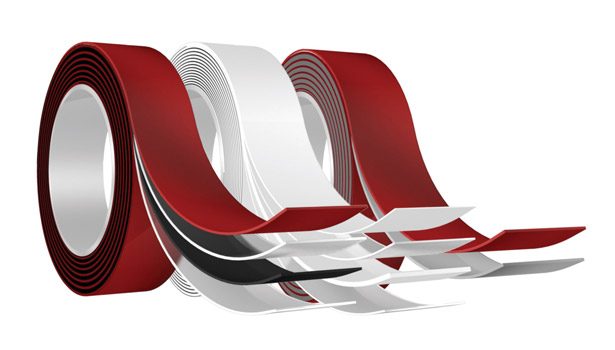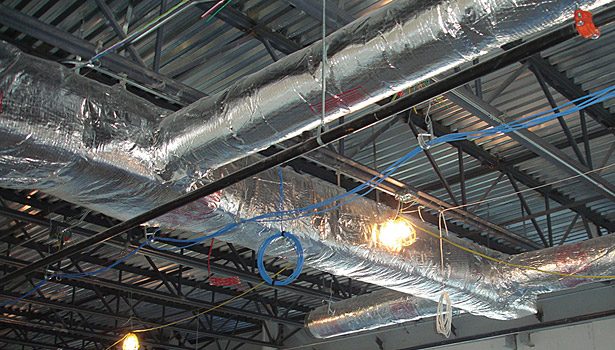Evolving Pressure-Sensitive Tape Adhesives
Technology is keeping pace with demands for increasingly industrial applications.



Tapes using advanced adhesives are used to connect, join, seal and patch flexible ductwork, and help create a secure vapor barrier for highly effective sealing.



Industries ranging from automotive and consumer electronics to building and construction are designing and manufacturing products that call for increasingly
| Jump to: |
sophisticated bonding solutions. New generations of advanced acrylic adhesive technologies used in pressure-sensitive tapes have been developed to keep pace with the evolving industrial requirements.
The innovative adhesive technologies provide design engineers and manufacturers with alternatives to conventional adhesives and bonding systems. They also offer new options for converters and fabricators who are producing parts and components for a host of industrial applications.
Exceptional Bonding Properties
High-performance adhesive technologies used in pressure-sensitive tapes are available in various product types and formulations, but share the same basic properties. They are characterized by exceptionally strong adhesion and superior resistance to harsh substances and environments.
The new generations of high-performance acrylic adhesives adhere to a variety of substrates. The adhesives exhibit high holding strength and strong bonding to a range of high-, medium- and low-surface-energy substrates, including metal, engineered plastics, polycarbonate, and polyester. They are resistant to harsh solvents, migratory plasticizers, gasoline, chemical cleaners and other chemicals, and can withstand UV light and humidity.
Good temperature performance is another common characteristic, and certain acrylics perform reliably at continuous temperatures up to 400°F and intermittent temperatures up to 450°F, making them ideal for high-temperature applications. Minimum operating temperatures can be as low as -40°F, allowing the adhesive technology to be forgiving in various application temperatures, and giving pressure-sensitive tapes the performance attributes necessary to address demands for sophisticated bonding.
Easy Processing
In addition to their performance characteristics, acrylic adhesives used in pressure-sensitive tapes allow for easy handling and processing. Some conventional adhesives tend to bleed at the edges, making processing and converting difficult. In contrast, the high-performance acrylics maintain their stability and integrity. They allow converters and fabricators to create complex die cuts at room temperature and to produce diverse shapes, without bleeding or oozing at the edges. This helps to reduce processing times and increase converting speeds while reducing the amount of waste material.
Acrylic tapes also have the ability to lay flat for easy parts stacking and processing. Often, they are available with moisture-stable liners that prevent the risk of wrinkling during the converting process.
Automotive Applications
High-performance acrylic tapes are well-suited to meet the demands of diverse industries. Automotive OEMs and suppliers, for example, can turn to top-tier adhesive tape developers for technical support and adhesive selection.
Noise and vibration damping continues to be an active area for innovation. In an effort to improve the driving experience, automotive OEMs continue to focus on
High-performance acrylic tapes are well-suited to meet the demands of diverse industries. Automotive OEMs and suppliers, for example, can turn to top-tier adhesive tape developers for technical support and adhesive selection. |
reducing noise from engines, brakes and other vehicle systems, and they are utilizing advanced elastomers and thermoplastic vinyls as vibration damping materials.
High-performance acrylic tapes can be used in tandem with the damping materials. They help to secure the materials in place and keep them functioning properly. These pressure-sensitive tapes can effectively laminate and bond multi-layered materials, such as the shims used to control vibration and improve function in brake assemblies.
High-performance adhesive solutions are available for the full range of automotive noise and vibration damping requirements, including low-, medium- and high-temperature applications, and those with high- and low-frequency vibrations. One high-performance solution combines high shear resistance and high temperature properties, making it ideal for vibration damping constrained layer applications. Another exhibits ultra-high adhesion, strong UV stability and resistance to solvents while remaining easy to die cut.
Insulation and HVAC Applications
Since poor weather conditions can impact construction activities, professional builders and contractors are naturally interested in materials and processes that remain effective in a wide range of conditions, including colder temperatures.
In insulation and HVAC applications, new generations of acrylic pressure-sensitive adhesives used in tapes have the potential to increase the construction time window. Conventional adhesives for sealing ductwork are limited by weather conditions. The adhesives are slow to dry and cure, and require relatively warm application temperatures. During cold periods, contractors must often bring portable heaters to the job site to promote adhesive bonding.
In contrast, the high-performance acrylic adhesives designed for these applications bond effectively at temperatures as low as 0°F, giving builders and contractors added flexibility. Tapes using advanced adhesives are used to connect, join, seal and patch flexible ductwork, and help create a secure vapor barrier for highly effective sealing.
Consumer Electronics Applications
Consumer electronics applications have stringent specifications for fit and performance, requirements that traditional bonding systems often cannot meet. Here, new generations of advanced acrylic adhesive technologies used in pressure-sensitive tapes offer an alternative. They bond both functional and protective product layers, provide enhanced optical clarity, resist impact forces, and meet chemical cleanliness standards.
Modern hard disk drives are another example. The drives have compact form factors, extremely tight tolerances and high requirements for speed and reliability. Advanced acrylic adhesives have superior bonding properties and exhibit low outgassing, meeting the application’s requirements for chemical cleanliness. Tapes are easy to die cut, enabling manufacturers to shape them precisely to fit the drive’s configuration. In operation, they help protect the disk drives from heat and vibration.
Advanced acrylic adhesives are well-suited for touchscreen applications for smartphones, tablet computers and other electronic products, with pressure-sensitive tapes available in versions as thin as 10 microns. They enable designers of consumer electronic devices to reduce the overall thickness of assembled components. In addition, tapes are ideal for the attachment of gaskets that cushion sensitive internal components from vibration and rattle, and protect them from dust and moisture. They provide design engineers and manufacturers with alternatives to conventional adhesives and bonding systems.
For additional information, contact the author at tom.epple@averydennison.com or visit www.tapes.averydennison.com.
Editor’s note: All images courtesy of Avery Dennison Performance Tapes.
Listen to our podcast with the author!
Looking for a reprint of this article?
From high-res PDFs to custom plaques, order your copy today!









